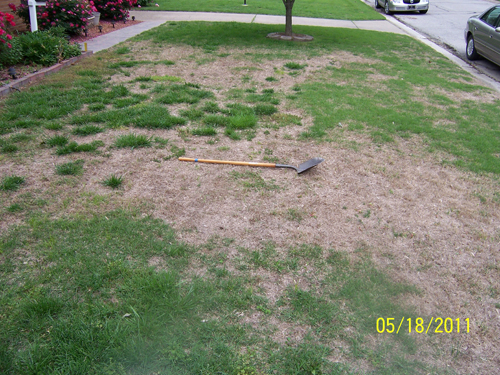Zoysia grass is a warm-season grass that is being more frequently used in warm, humid and transitional regions. As zoysia is becoming more frequent in our state we are learning more about the pests that attack it. The photograph below was taken of a stand of zoysia in the southern part of Indiana. It was clearly killed by something – but what? Damage was evident in the late fall and got even worse this spring. We went through the usual bank of questions; diseases, winter kill, billbugs, but came up with no certain cause of decline.
At last, a sample was run through a Berlese funnel that uses heat and light as a method to extract live insects. In addition to the myriad of mites that are found in nearly every soil sample, we extracted many small red insects with white stripes across their backs (photo below).
These were identified as newly hatched chinch bugs. Looking back at the weather conditions last fall, it became apparent that this zoysia lawn occurred right in the middle of the drought affected region of the state. Interestingly, chinch bugs are also known to occur most in times of drought.

Putting two and two together allowed us to make a tentative diagnosis of a difficult problem. Certainly, the drought must have played a part in the decline of the turfgrass, but finding the chinch bugs also allowed us to say with certainty that they also contributed, AND are continuing to contribute to this damage.
Chinch bugs have piercing-sucking mouth parts and suck juices from the crowns and stems of grasses. Adults are black and have shiny white wings that are held flat across the back. The newly hatched nymphs (1st and 2nd instars) are bright red in color and have a characteristic white strip across their back. As they grow they slowly change to a brown, and eventually black, color and the white stripe vanishes.
 Natural controls often hold these pests in check, however, when conditions (including weather) are just right, populations can build up and damage may be manifest.
Natural controls often hold these pests in check, however, when conditions (including weather) are just right, populations can build up and damage may be manifest.
Chemical control should only be considered when the chinch bugs are confirmed in high numbers and damage begins to become apparent. Otherwise, insecticides often take out the very predatory insects that keep chinch bugs in check.
Insecticides recommended for chinch bug control include any of the pyrethroids labeled for use in turf.
Tim Gibb, Turfgrass Entomologist
Doug Richmond, Turfgrass Entomologist